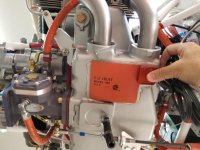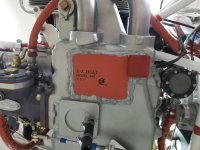Question for the knowledge bank: I realized this isn't directly on the oil sump. Right? This is the cold-air intake. Ryan
The sump heat pad should warm the metal which will warm the part of the sump that does have oil. So basically you have something like a "dry sump". There is oil in the sump but not where the heat pad is as I understand it. It will add heat to the engine and the oil, just not as as much. Does the pad have thermal protection? It may get hot on the sump with no oil to absorb (as much) heat and shut off or throttle? You may want to ask the manufacture.
You live in Arizona and need a heater? Ha ha. I realize parts of AZ in winter can get below freezing, but not the South West part. However spring , summer and fall most of AZ is considered warm. I know AZ folks think 60F is cold. Ha ha. I would however revisit the do you really need this. Starting a Lyc and warming up in the 30's is pretty routine and normal. The heat pad might reduce your warm up time a little, but I don't think it will improve or reduce wear and tear on engine. Most wear is due to disuse.
You can always get an external engine heating system that blows hot air into the cowl. Passive things like cowl blanket and inlet plugs help, and even a space heater in the area (but not too close to the plane). You have to be VERY careful but it an be done safely. I assume you have a hanger. If you are out on a ramp plugging in the heater is problematic.
Lycs can easily start and warm up in near freezing conditions with out any real fear of wear or damage. THE BIGGEST DAMAGE TO YOUR ENGINE IS NOT FLYING OFTEN... You let them sit moisture and corrosion takes over.
Lyc has service letters and technical data about when then engine is warm enough to go flying to ease your mind when you start up on a bone chilling Arizona 49F winter day. Ha ha.
On the same note once airborne you do want the engine to HEAT UP. If you are flying around with sub 190F oil temperature you are not burning off then moisture and blow-by that dilutes the oil.
As a data point "dry sump" planes (Continental) use heating elements that wrap around the base of the cylinders. They heat the cylinders and case and indirectly the oil.
Last I was flying an old PIPER Apache twin daily in Washington state to commute to work. I used oil dip stick heaters. They worked but were made for cars. I would not recommend it but it worked and was cheap. I removed the dip sticks and inserted these heaters (that only got hot last few inches which the oil covered) and plugged them in. Once I got to the plane I unplugged them and allowed them to cool for a few minutes while I did my walk around. The dip stick tubes are plastic. After removing them I put the dip sticks back. I had to blast off early in the morning everyday and I wanted to cut time to warm up oil after start. It did help. Was it needed since NW Washington state has fairly mild winters? I think it helped more keeping moisture down. I sold the plane with 2300 hrs on engines that burned 1Qt every 10 hours and had very good mid high 70's compression. However what helped most was it flew everyday.






